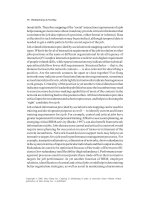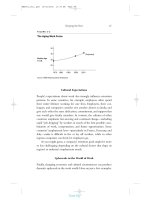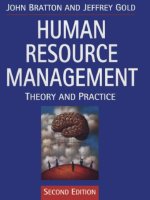Understanding business 10th chapter 11 human resource management finding and keeping the best employees
Bạn đang xem bản rút gọn của tài liệu. Xem và tải ngay bản đầy đủ của tài liệu tại đây (930.99 KB, 48 trang )
Chapter Eleven
Human Resource Management: Finding and Keeping the Best
Employees
McGraw-Hill/Irwin
Copyright © 2014 by the McGraw-Hill Companies, Inc. All rights reserved.
HUMAN RESOURCE
MANAGEMENT (HRM)
•
Human Resource Management -- The process of determining human resource needs
and then recruiting, selecting, developing, motivating, evaluating, compensating and
scheduling employees to achieve organizational goals.
•
HRM’s role has grown because:
1.
Increased recognition of employees as a resource.
2.
Changes in law that rewrote old workplace practices.
11-2
HUMAN RESOURCE MANAGEMENT
11-3
HR & Legal Issues
11-6
CIVIL RIGHTS ACT of 1964
Title VII prohibits discrimination in hiring, firing, compensation, apprenticeships, training,
terms, conditions or privileges of employment based on:
-
Race
Religion
Creed
Sex
Age
National Origin
11-7
1972 EQUAL EMPLOYMENT OPPORTUNITY ACT (EEOA)
•
Strengthened the Equal Employment Opportunity Commission (EEOC).
•
Gave EEOC the right to issue workplace guidelines for acceptable employer conduct.
•
EEOC could mandate specific recordkeeping procedures.
•
EEOC was vested with the power of enforcement.
11-8
CONTROVERSIAL PROCEDURES
of the EEOC
•
Affirmative Action -- Policy designed to “right past wrongs” by increasing opportunities for
minorities and women in the workplace.
•
Reverse Discrimination -- Discrimination against whites or males in hiring or promoting.
These policies have been at the center of many debates and lawsuits.
11-9
CIVIL RIGHTS ACT of 1991
and OFCCP
•
Civil Rights Act of 1991
-
Amended Title VII and gave victims of discrimination the right to a jury trial and
possible damages.
•
Office of Federal Contract Compliance Programs (OFCCP)
-
Ensures that employers doing business with the federal government comply with the
nondiscrimination and affirmative action laws.
11-10
LAWS PROTECTING
EMPLOYEES with DISABILITIES
Americans with Disabilities Act of 1990 (ADA)
-
Requires employers to give applicants with physical or mental disabilities the same consideration for
employment as people without disabilities.
-
Passage in 2008 of Americans with Disabilities Amendments Act
expanded protection.
-
2011 saw new regulations that widen the range of disabilities
covered by the ADA and shift the burden of proof of disability from
employees to employers.
11-11
AGE DISCRIMINATION in EMPLOYMENT ACT (ADEA)
Age Discrimination in Employment Act (ADEA)
Protects workers 40 and older from employment
and workplace discrimination in hiring, firing,
promotion, layoff, compensation, benefits, job
assignments and training.
11-12
MINDING the LAW in HRM
•
Employers must know the law and act accordingly.
•
Legislation affects all areas of HRM.
•
Court cases highlight that sometimes it’s proper to go
beyond providing equal rights.
•
Changes in law and legislation occur regularly.
11-13
HUMAN RESOURCE MANAGEMENT
HR Must Plan for the Future
5 STEPS in the
Human Resource
Planning Process
11-14
STEPS in the HUMAN RESOURCE PLANNING PROCESS
1.
Preparing a human resource inventory of
employees.
2.
Preparing a job analysis.
3.
Assessing future human resource demand.
4.
Assessing future labor supply.
5.
Establishing a strategic plan.
11-15
WHAT’S a JOB ANALYSIS?
•
Job Analysis -- A study of what employees who holds various job titles do.
•
Job Description -- Specifies the objectives of the job, the type of work, the responsibilities
and duties, working conditions and relationship to other jobs.
•
Job Specifications -- A summary of the minimal education and skills needed to do a
particular job.
11-16
HUMAN RESOURCE
MANAGEMENT (HRM)
The process of determining human resource needs and then recruiting, selecting,
developing, motivating, evaluating, compensating and scheduling employees to
achieve organizational goals.
11-17
RECRUITING EMPLOYEES
•
Recruitment -- The set of activities for obtaining the right number of qualified people at the
right time.
•
Human resource managers use both internal and external sources to recruit
employees.
•
Small businesses often make use of web sources like CareerBuilder and Monster
to recruit employees.
11-18
RECRUITING EMPLOYEES
•Recruiting
•Internal
•Less expensive
•Maintains morale
•External
11-19
EMPLOYEE SOURCES
11-20
THE HIRING PROCESS:
SELECTION
11-21
SELECTION
•
Selection -- The process of gathering information and deciding who should be hired, under
legal guidelines, to fit the needs of the organization and individuals.
11-22
STEPS in the
SELECTION PROCESS
1.
Obtaining complete application forms
2.
Conducting initial and follow-up interviews
3.
Giving employment tests
4.
Conducting background investigations
5.
Obtaining results from physical exams
6.
Establishing trial (probationary) work periods
11-23
CONTINGENT WORKERS
11-25
HIRING CONTINGENT WORKERS
•
Contingent Workers -- Workers who do not have an expectation of regular, full-time
employment.
•
Include part-time and temporary workers, seasonal workers, independent contractors,
interns and co-op students.
•
There are about 5.7 million contingent workers in the U.S.
•
Majority of contingent workers are under 25.
11-26
WHY HIRE
CONTINGENT WORKERS?
•
Companies hire contingent workers:
-
When full-time workers are on leave
-
During periods of peak demand
-
In uncertain economic times
-
To save on employee benefits
-
To screen candidates for future employment
11-27
TRAINING and DEVELOPING EMPLOYEES
11-29









